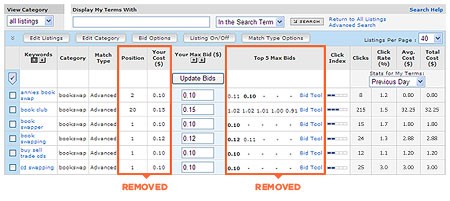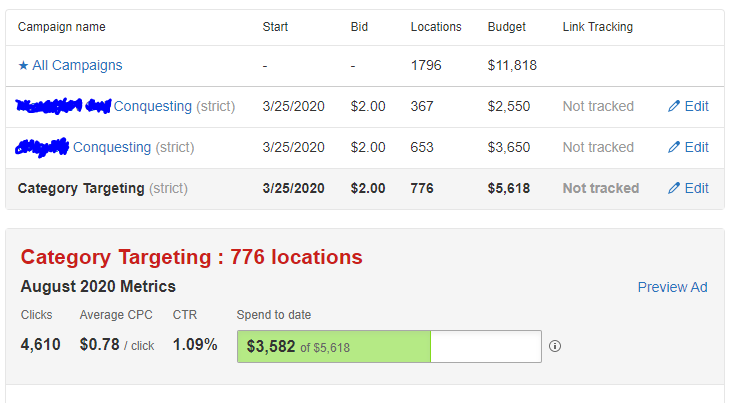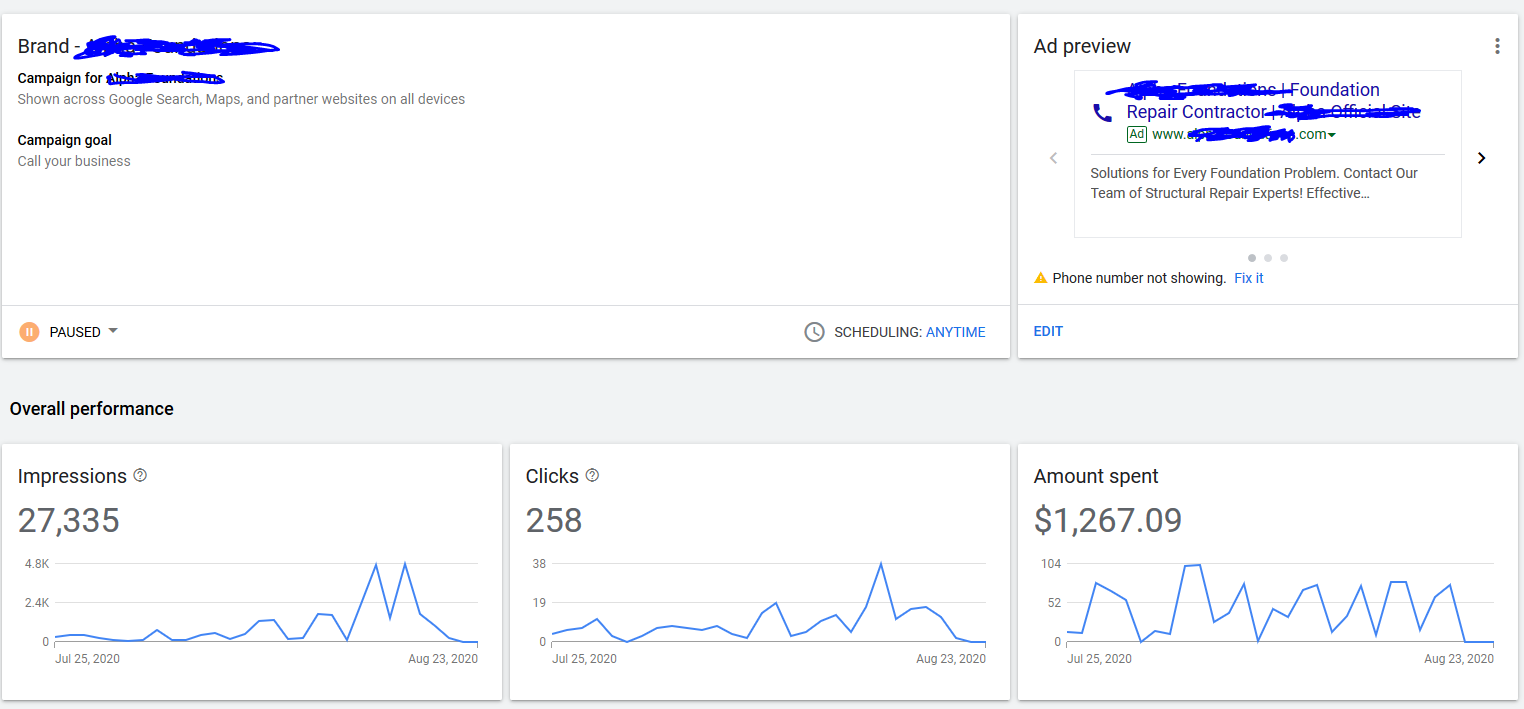Keywords – the most important thing to you in search – is going the way of the Old Yeller.
Anyone who has been in search for more than 10 years recalls the days of when your Yahoo Overture/Panama keywords in standard or advanced match types, were the lifeblood of your SEM efforts.
You had to make sure your keyword list was as robust as possible, looking at both long tail and short tail, because without that extensive keyword list, your coverage (this is pre-close match variants) could be limited.
For a fun time, go find your nearest search OG (anyone that has been doing this since 2007 or earlier), and ask them what “bid jamming” is.
Then pull up a chair and let them ramble for 2 hours.
 The old Yahoo Overture Bid UI (image circa 2006)
The old Yahoo Overture Bid UI (image circa 2006)Fast forward to today and all you can hear in the back of your head is Google Ads and Microsoft Advertising, laughing at your attempts to build a keyword list.
Why?
Because keywords in SEM are starting to serve less and less value.
Think of them as having the lifeguard at the swimming events in the Olympics, a “nice to have, but not necessary.”
The Era of Keywordless Search
So where’s the evidence keywords have less value?
Most of us (especially SMBs) are already going through the keyword SEM life.
Let’s review the examples.
Yelp
The little local listings/review search platform.
More specifically, the local search platform that the big G, for some reason, just cannot seem to overtake.
There isn’t really much to manage.
You provide the bid and the target (i.e., competitor, brand, category, etc.), then your ads trigger based on your search on the platform.
Seem like a waste/pointless/poor example?
Well, remember, just about every restaurant under the sun is on Yelp – not to mention service-based operations.
Start adding up all these SMBs, and if even a fraction of them run paid Yelp ads, you suddenly realize that keywordless search has truly begun to snake its way into the industry.

Still need more proof that keywords are going the way of old yeller?
Well, let’s talk about…
Microsoft Advertising
Ah, yes, the lovable little search ads platform formerly known as Bing Ads.
Surely, they would never surrender keywords on me, right?
Wrong.
Don’t take it that I dislike Bing/Microsoft.
In fact, I am a huge fan of their work in certain verticals, especially healthcare (see one of my prior articles: Why Bing Should Be First in Your Healthcare Search Strategy [DATA]).
That said, they too, have headed in the world of keywordless search.
Bing gets you at three different angles (just off the top of my head):
- Shopping/Product Listing Ads (PLAs): You know what it is, you love it, you run it. But there are still no keywords involved.
- Dynamic Search Ads (DSAs): Scrapes your site, decides what queries you should show for. Hey, at least it lets you design a fraction of the ad and still feel like you have a purpose.
- Audience Ads: Bing’s answer to GDN. No keywords needed, just some remarketing or audience segmentation lists, and a hope that people still spend time on MSN.com.

Amazon
I feel like this is the most self-explanatory (unless you’re doing self-service/manual).
We give Amazon money and a target.
They run with it.

Yes, it is search. Social/search.
You search, you engage, the ads follow you… forever.

Google/GDN/YouTube
Now for the big G.
Yes, you can still do keyword targeting here, across most of their ads.
But if anyone is trying to get rid of the keyword faster, it is them.
Just like Microsoft, Google is pushing the Shopping and DSA ads.
But wait, there is so much more:
Discovery
Your ad appears and you get some info on where it triggers, but it is just audiences.
Local
Honestly, I question if they even know what words/movements trigger the ads. But they work. With or without audience targets.
Smart Campaigns
The coup de grâce.
A campaign where you set up a campaign with an audience and an ad, and you’ll get some high-level numbers back.
No keywords.
(Disclaimer: Being a large enterprise operator, I personally detest Smart Campaigns due to lack of transparency, but if you’re a single person shop/SMB operation, it’ll save you a bundle of time.)

So yes, I just wrote out all those examples to reiterate my point: we’re already moving toward a keywordless search operation.
The only remaining question is:
“Are you prepared?”
Odds are, if you found this article’s title interesting, and you’re still reading it to this point, then you’re either not prepared, or not fully confident.
That is OK.
There is time for you.
So What Should You Do?
Important: Do not delete your keywords, regardless of how this article finishes or influences you.
Keywords are not gone and are still necessary.
But what is about to become even more necessary for you to work with is: audiences.
Whether it be detailed demographics pinpointing women 25-34 who own a home and have children under age 7, to people who abandon your shopping cart with 3+ items in it, or those whose LinkedIn profiles indicate they are office administrators.
They just became as important (if not more important) than your piddly little “keyword strategy.”
Step 1: Get Your Messaging on Point
For areas that you can control (i.e., ads), make sure they are in tip-top shape.
This means examining what messaging works best in regular keyword search, Facebook, GDN, etc.
This messaging should be consistent, but don’t let one platform dictate it.
The “sharing is caring” method of asset analysis is huge.
Look for commonalities in your messaging of top performers across platforms, to roll out your new super ads (applicable for Discovery, DSA, Local, Facebook, and Smart campaigns).

As for Shopping campaigns – there are a lot of different schools of thought about what is best.
I must admit, I find Google’s best practices guide for optimizing a product feed to be the best.
Remember, just because it appears on your site one way, does not mean that is how people will search for it, or even follow the messaging.
Be concise, to the point on the product and benefits.
Check out Google’s tips to optimize your product data.
Also, if you’re looking for some folks that really know their stuff when it comes to shopping, the list of brilliant folks are bottomless, but I recommend following on Twitter:
- Kirk Williams of Zato Marketing.
- Bryant Garvin of Groove.
- Duane Brown of Take Some Risk.
Step 2: Learn Your Audiences
When your targeting is moving away from keyword-driven, then the next best thing you can do is, decide who can see your ad to start off with.
The basic rule of thumb: Just because someone can trigger your ad, does not mean they are qualified to engage on your site.
Therefore, you must start to collect and build audiences of who should really be served your ads.
By cross-referencing inbound site data by persona and channel, you can then take your “Super Ads”, and deliver it to the right folks.
For example, I know my Male, U.S., audience that enters via Email is a top performer.
But by crossing it by behavior, I can refine that audience to recognize they are in the market for employment.
I take those learnings and make an audience for it, considering it highly qualified.
Spinning off from that, a lookalike audience will formulate:

This maximizes the qualification of a prospect, severed them the ideal ad (in my opinion), and did it all without keywords.
You should create different audience classifications, to know your expansion level of targeting.
I like to do:
- Remarketing-Converter-Bottom of Funnel (low volume).
- Remarketing-Abandoner-Mid Funnel (low volume).
- In-Market Prospecting-Mid to High Funnel (medium volume).
- Look alike of Converter-Mid to Low Funnel (medium to high volume).
- Affinity Non Visitor-Prospecting-High Funnel (high volume).
This grouping can be more easily deployed, with a better sense of traffic volume and performance.
Note, Google Analytics has a beta on select accounts to pull together audiences based on probability to convert, which makes the cutting down process a lot easier for the marketer.

Step 3: Merge Your ‘Super Ads’ with Your Audiences
Fairly self-explanatory. You just created the best possible ad with your data.
You also just found the ideal audience segmentation for yours.
Now you combine them together.
I like to use all audiences in search (reactive media), as there is a degree of prequalification, as the consumer is searching for you.
Just don’t roll it all out at once, usually in waves.
For non-query based ads, I recommend sticking to the mid to low funnel.
Unless you are keen on building site traffic for data harvesting, this will help maximize ROAS, as best one can.
The Takeaway
As of today, keywords still exist.
There is no formal documentation or timeline of their extinction.
But the engines have begun to put less need for them, and a clear need to let automation take over.
Therefore as advertisers, we must return to the basics of search: right person, right message, right time.
And that can be achieved through audience targeting and segmentation.
More Resources:
- What Are Keywords & How They Work in PPC
- How to Do PPC Keyword Research
- How to Use Keyword Intent to Boost PPC Performance
Image Credits
All screenshots taken by author, September 2020





